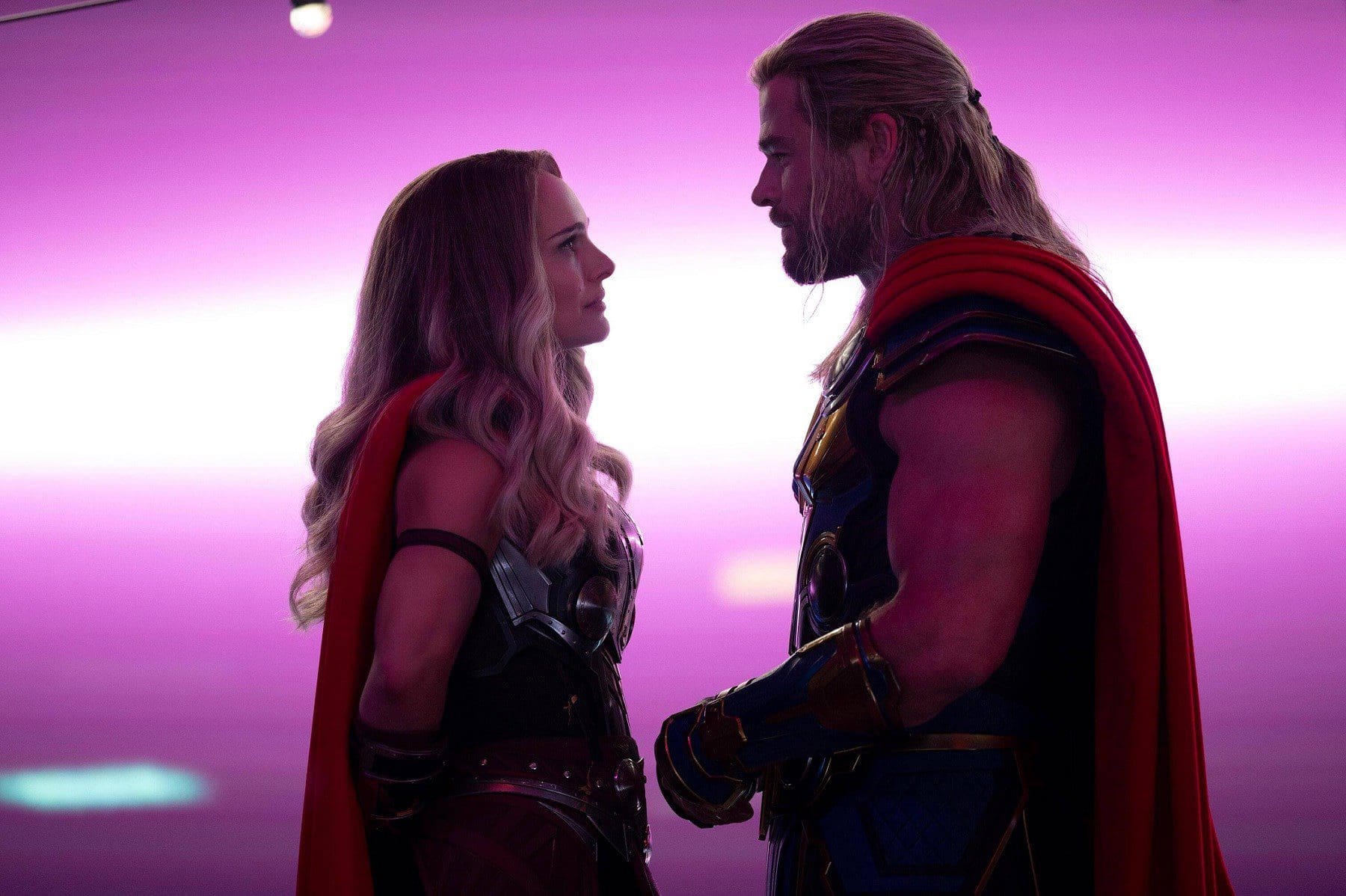
When Matt Damon played “actor Loki” opposite Luke Hemsworth’s “actor Thor” and Sam Neill’s “actor Odin” in Thor: Ragnarok, the schlocky theatrical production complemented their place as the King’s jesters. When they appear in Thor: Love and Thunder, the same schlock feels fit for a theme park. That shift captures Asgard’s evolution from a place of Norse legend to an Earthbound tourist trap. Asgardian flying ships serve the same purpose horses and carriages do in New York City. The shattered remains of Thor’s hammer, Mjonir, a powerful weapon that was the center of Thor’s arc in his first film, are now protected by glass so tourists can’t steal them while some minimum wage guide explains their significance.
The fantastic world of Asgard that contrasted the everyday Earth is now one in the same. Asgardian nobility is no longer conveyed with a gargantuan throne room but with monotonous everyday politics faced by their King, Valkyrie (Tessa Thompson). So, when Gorr the God Butcher (Christian Bale) kidnaps Asgardian children as part of his plan to kill the gods, Thor’s (Chris Hemsworth) mighty nature doesn’t reassure his people. In contrast to the first film, where Thor’s epic self seemed silly to Jane but had its place in Asgard, Thor now looks silly even to Asgardians.
Telling another “Thor needs to find himself” story may seem repetitive at this point, but it’s more relevant than ever. With the MCU’s explorations into the multiverse, the cosmos, and Avengers: Endgame affirming that others can wield weapons only Thor previously could, what does it mean to be Thor anymore? As the only original Avenger still around, it’s easy for both characters and audiences to look at him as the loser who’s overstayed his welcome.
To really drive the point home, even his ex Jane (Natalie Portman) wields the mighty Mjonir! She hasn’t just moved on emotionally, she doesn’t need his mighty powers either.
The speed at which Jane gets these powers is, admittedly, a little rushed. To compound the issue, Jane has a separate life event (unspoiled in this review) that leads to her wielding Mjonir, and neither feel like they’re given their proper due in the first 20 minutes. But after these first 20 minutes, Love and Thunder makes up for Ragnarok’s lack of Jane. Waititi’s silly style blends with their romance beautifully. One of the film’s highlights is a romantic comedy montage, expanding on the “fish out of water” theme of the first film with a shift in genre. (Thor using Mjionir to pull him and Jane while they roller-skate is probably a highlight for the character in general). There’s an equally delightful recurring joke where Thor acts flustered around Mjonir, like the hammer is an ex, while Stormbreaker non-verbally conveys jealousy.
Comedy has, of course, been an MCU trademark since its inception. What differentiates these last two Thor films is that Waititi’s humor doesn’t really subvert the epic elements. He sees the fantasy as just as absurd, just as believable, and just as true as the humor.
To compare: in Guardians of The Galaxy Vol. 2, the epic group shot in the climax is subverted and undermined by the gag of Mantis getting hit in the head. In Doctor Strange, Kaecilius’s weighty exposition is subverted and undermined not just by Strange’s “look at your face” gag, but by the brief close-up of Kaecilius that reinforces said gag. While solid movies, moments like this can detract from the earnestness and can take the audience out of the moment.
Conversely, Waititi doesn’t use the humor to necessarily undermine other dramatic moments, but instead to contribute to a sillier, greater, grander tone. In a scene where Gorr has the two Thors and Valkyrie trapped in the shadow realm, Bale creepily plays off the other cast members with ease, with one moment especially standing out. Gorr gets in Thor’s face, incessantly and eerily repeating, “call the axe.” Thor makes a brief jab about Gorr’s hideous teeth, which the audience is very much meant to laugh at. However, unlike the Doctor Strange jab, Love and Thunder doesn’t undermine Gorr with a throwaway close-up of his teeth. Instead, it lets him bounce off Thor’s jab with his neurotic, demonic eeriness.
These contrasts come together in the simple climax, where the heroes and villain quite literally face eternity together. In the face of eternity, their respectively silly and terrifying natures culminate into one of the grandest and most wholesome moments not just in Thor’s series, but the MCU in general. Following this grandiosity, the film ends on a tone with similar silliness to the “romantic comedy” montage. Yet no romance is present, just love and thunder, and it’s in this ending montage that Thor’s place in the universe is re-established. Amidst the ever-expanding number of Thors, the ever-expanding cosmos, and the ever-expanding MCU, the former King of Asgard finds his purpose for the fourth and most significant time: to provide love, and thunder.


Comments are closed.